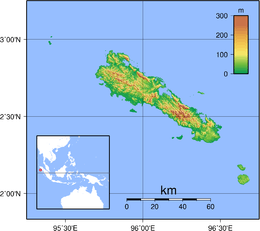Simeulue
 | |
| Geography | |
|---|---|
| Location | South East Asia |
| Coordinates | 2°35′N 96°05′E / 2.583°N 96.083°ECoordinates: 2°35′N 96°05′E / 2.583°N 96.083°E |
| Area | 2,310 km2 (890 sq mi) |
| Highest elevation | 567 m (1,860 ft) |
| Highest point | unnamed |
| Administration | |
|
Indonesia | |
| Province | Aceh |
| Regency | Simeulue Regency |
| Largest settlement | Sinabang |
| Demographics | |
| Population | 82,100 (2007 census) |
| Pop. density | 35.5 /km2 (91.9 /sq mi) |
Simeulue is an island of Indonesia, 150 kilometres (93 mi) off the west coast of Sumatra. Its capital is Sinabang.
Simeulue was once a part of West Aceh Regency but was split off in 1999 and became a separate Simeulue Regency.
Demographics
From the ethnic point of view the inhabitants of Simeulue are similar to the people of neighboring Nias Island. Two languages and a number of dialects are spoken on the island: Devayan and Sigulai, which are different from the languages spoken in the north of Sumatra.[1] The majority of the island's population is Muslim.
2004 Indian Ocean earthquake
Simeulue was close to the epicenter of the 9.3 magnitude 26 December 2004 earthquake.
On 28 March 2005, an 8.7 magnitude earthquake struck with its epicenter just off the south end of the island.[2] During the earthquake, Simeulue rose at least six feet on the western coast; this left the flat top of its coral reefs above high tide. On the east coast, the land was submerged, with seawater flooding fields and settlements.[3]
Local wisdom
Although Simeulue Island was only 60 kilometers from the epicenter, while Banda Aceh was about 250 kilometers, only six residents died while the remaining 70,000 persons were safe, due to local wisdom called 'smong'; this dictated that after an earthquake, if the tide suddenly receded, people should evacuate to highland as soon as possible.[4]
See also
References
- ↑ BPS Kabupaten Simeulue (2003). Simeulue Dalam Angka 2012. BadanPusatStatistik.Com. ISBN 0-0100-0021-6.
- ↑ Gibbons, Helen (April 2005) "Second Tsunami Causes Damage in Indonesia—USGS Scientists Post Observations on the World Wide Web" United States Geological Survey
- ↑ Saved by tsunami folklore, BBC News From Our Correspondent, 10 March 2007
- ↑ "Pulau Simeulue". October 13, 2013.
External links
 Media related to Simeulue at Wikimedia Commons
Media related to Simeulue at Wikimedia Commons